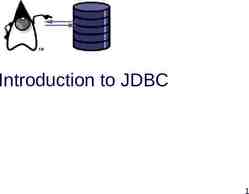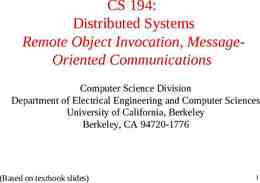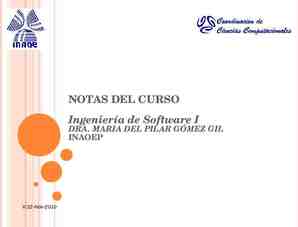Introduction Chapter 1
35 Slides1.07 MB
Introduction Chapter 1
Instructor Textbook Ming-Feng Chang, [email protected] EC 425, 5731812 “Carrier Grade Voice over IP.” D. Collins, 2nd ed., McGraw-Hill, 2003. Additional technique reports and papers Requirements Homework and machine problems 25% One mid-term exam 45% One term project 30% Internet Telephony 2
Telephone 1876 Alexander Graham Bell transfered voice over wire for the first time. Direct connection; telephones are sold in pair F A E B D C Internet Telephony 3
Switches As the number of users increases, switching centers are more economical F A E B D C Internet Telephony 4
Digital Switches Took more than 100 years from analog to digital voice transmission Better quality for long distance calls Demands to telephone network become constantly higher World-wide communication network Internet Telephony 5
Mobile Communications Bell Laboratories introduced the idea of cellular communications in 1947 Motorola and Bell Labs in the 60s and early 70s were in a race to design portable devices Dr. Cooper, 2-pound Motorola handset (1973) Internet Telephony 6
The Internet Data Networks since 1960’s ARPA*-Net 1969 Internet since early 1990’s Internet Telephony 7
What is VoIP? Use a LAN and/or WAN to carry voice in the same way as the telephone system. Why? Save costs Improve facilities. IP WAN/ INTERNET VoIP VoIP Internet Telephony 8
VoIP Gateway The interface between VoIP and PSTN PSTN to IP Gateway Internet VoIP POTS An essential feature for VoIP Internet Telephony 9
Cheap phone-cards/voice carriers POTS POTS PSTN to IP Gateway e.g. UK IP Network PSTN to IP Gateway (with QoS for voice) e.g. Australia Internet Telephony 10
Carrier Grade VoIP Carrier grade and VoIP mutually exclusive A serious alternative with enhanced features Carrier grade The last time when it fails 99.999%, five-nines reliability Verizon network supports 70M voice access lines AT&T serves 300M voice calls a day Short call setup time, high speech quality no perceptible echos, noticeable delay or annoying noises Self-healing, highly scalable and manageable Internet Telephony 11
VoIP Transport voice traffic using IP Voice over the Internet? The greatest challenges Interconnected networks Applications: e-mail, file transfer, e-com Voice quality and bandwidth Control and prioritize the access Internet: best-effort transfer The next generation VoIP ! Internet telephony Internet Telephony 12
IP A packet-based protocol Packet transfer with no guarantees Routing on a packet-by-packet base May not receive in order May be lost ore severely delayed TCP/IP Retransmission Assemble the packets in order Congestion control Useful for file-transfers and e-mail Internet Telephony 13
Data and Voice Data traffic Voice traffic Asynchronous – can be delayed Extremely error sensitive Synchronous – the stringent delay requirements More tolerant of errors IP is not for voice VoIP must Match the PSTN Offer new and attractive capabilities at a lower cost Internet Telephony 14
Why VoIP? Why carry voice? Internet support instant access to anything Everything can be done on the net? “Dot-com guy” Many new services and applications However, voice services provide more revenues Why use IP for voice? Why try to fix something that is not broken? Circuit-switching is not for datacom IP Equipment cost, integrated access, less bandwidth, and widespread availability Internet Telephony 15
Lower Equipment Cost PSTN switch Mainframe computer The IP world Proprietary – hardware, OS, applications High operation and management cost Training, support and feature development cost Standard hardware and mass-produced Application software is quite separate A horizontal business model IN does not match the openness and flexibility of IP A few highly successful services Internet Telephony 16
Moore’s Law Processing power doubles every 18 months Frame 10 Router 20 ATM 40 Circuit 80 Internet Telephony 17
Voice/Data Integration Click to talk application Web collaboration Personal communication E-commerce CTI – Computer Telephony Integration Shop on-line with a fried at another location Video conferencing IP-based PBX IP-based call centers Internet Telephony 18
Lower Bandwidth Requirements PSTN Sophisticated coders 32kbps, 16kbps, 8kbps, 6.3kbps, 5.3kbps GSM – 13kbps Save more by silence-detection Traditional telephony networks can use coders too G.711 - 64 kbps Human speech bandwidth 4K Hz The Nyquist Theorem: sample rate twice the bandwidth 8K * 8 bits But it is difficult So many switches VoIP – two ends of the call negotiate the codec Internet Telephony 19
The Widespread Availability of IP IP VoFR or VoATM LANs and WANs The ubiquitous presence Only for the backbone of the carriers Voice over WLAN Voice over WiFi for now Voice over WiMax could be a real threat for PLMN Internet Telephony 20
The VoIP Market The revenue projection Value-added service Internet Telephony 21
Revenue breakdown VoIP Fax over IP Internet Telephony 22
VoIP Challenges Speech quality Must be as good as PSTN Delay The round-trip delay International calls through satellite – 500-600 ms G.114 – 300 ms Jitter Delay variation Different routes or queuing times Adjusting to the jitter is difficult Jitter buffers add delay Internet Telephony 23
Packet loss Traditional retransmission cannot meet the real-time requirements Packets must be played in order Speech-coding techniques MOS, Mean Opinion Score 4 P.800, but subjective in nature G.711 64kbps 4.3 G.726 32kbps 4.0 G.723 (celp) 6.3kbps 3.8 G.728 16kbps 3.9 G.729 8kbps 4.0 GSM 13kbps 3.7 iLBC 13.33/15.2kbps high robustness to packet loss iSAC 10-32kbps wideband codec Internet Telephony 24
Network Reliability and Scalability PSTN system fails Five-nines reliability The office computer network fails Today’s VoIP solutions Redundancy and load sharing Scalable too – easy to start small and expand Fiber-optic transport, gigabit router, high-speed ATM base Internet Telephony 25
Managing Access and Prioritizing Traffic A single network for a wide range of applications Call admitted if sufficient resources available Different types of traffic are handled in different ways QoS has required huge efforts Internet Telephony 26
VoIP Implementations IP-based PBX solutions A single network Enhanced services Internet Telephony 27
IP voice mail Hosted PBX solutions One of the easiest applications For SOHO Internet and telephony access IP call centers Use the caller ID Automatic call distribution Load the customer’s information on the agent’s desktop Click to talk Internet Telephony 28
Internet Telephony 29
IP user devices VoIP protocols, SIP Integrated functions Telephony, WWW, e-mail, voice mail, address-book WiFi phone Internet Telephony 30
Skype A peer-to-peer VoIP client developed by KaZaa in 2003 Skype can work almost seamlessly across NATs and firewalls has better voice quality than the MSN and Yahoo IM applications encrypts calls end-to-end, and stores user information in a decentralized fashion SkypeOut, SkypeIn Internet Telephony 31
New applications The networks are converging Possible applications Video Phones Conferencing Collaboration Tools Distance Learning / Training Tele-medicine, tele-repair, tele- On-line gaming Dating Applications Skype is rolling out developer kits and programs to encourage innovation, similar to the wireless industry promoting application development on their platforms Internet Telephony 32
Why Internet Telephony? The business case Integration of voice and data Bandwidth consolidation Tariff arbitrage Universal presence of IP Maturation of technologies The shift to data networks Internet Telephony 33
VoIP Spectrum Traditional Telecomm Segments in transition to VoIP International Low cost calling Internal networks of large carriers Numerous equipment makers, software providers Residential VoIP phone service Office PBX systems Using VoIP inside a company location, and between corporate branches Call Center Instant Messaging This area is exploding: Vonage, Packet8, Broadvoice Not only the traditional big 3, but newcomers like Skype Consumer and Business Application Areas Voice applications Wireless Internet applications Internet Telephony 34
Course Overview VoIP and RTP Voice codecs H.323 SIP – simple and flexible MGC and softswitch SS7, UMTS QOS Voice over WLAN P2P IP communications Charging and payments Internet Telephony 35








































